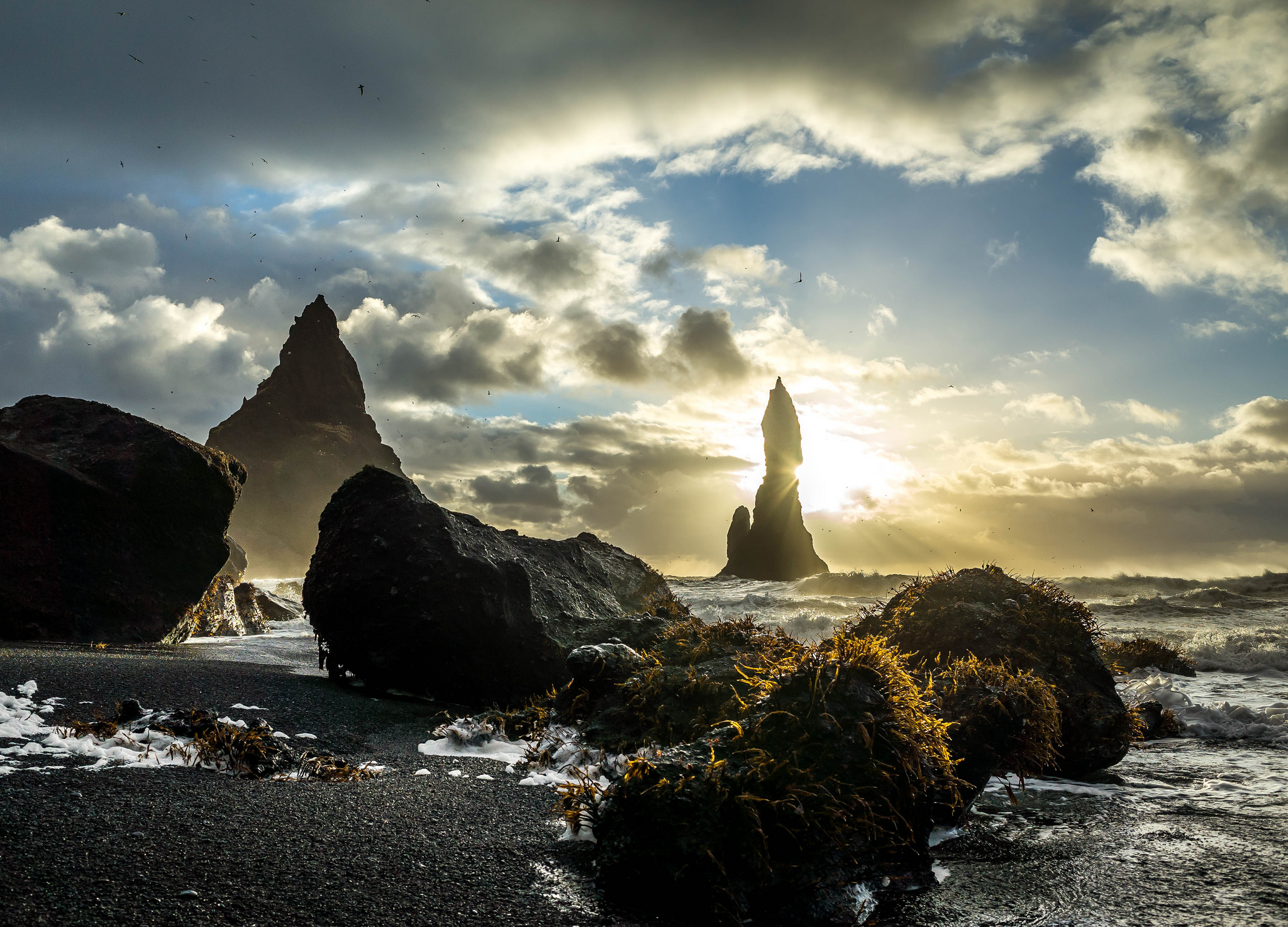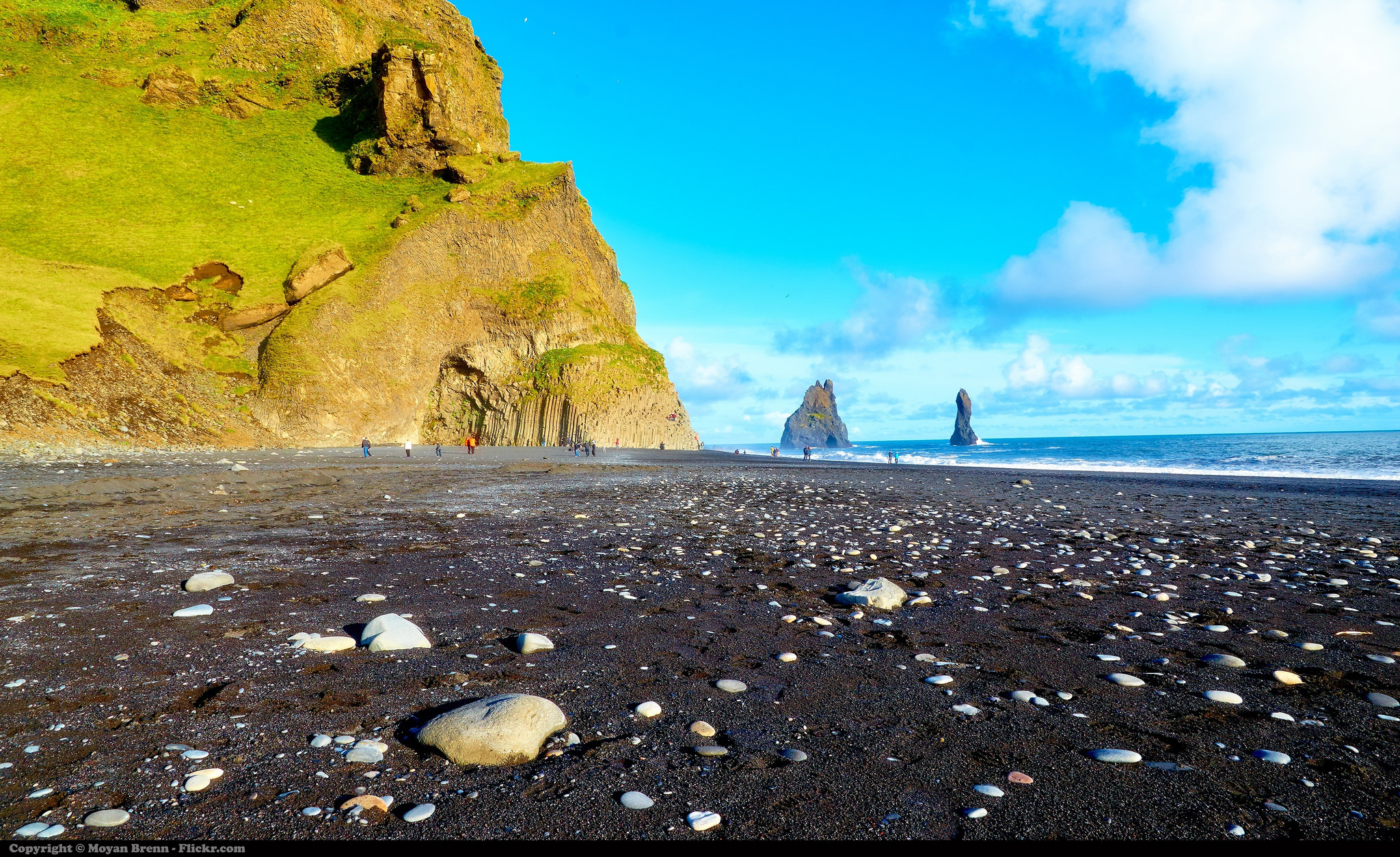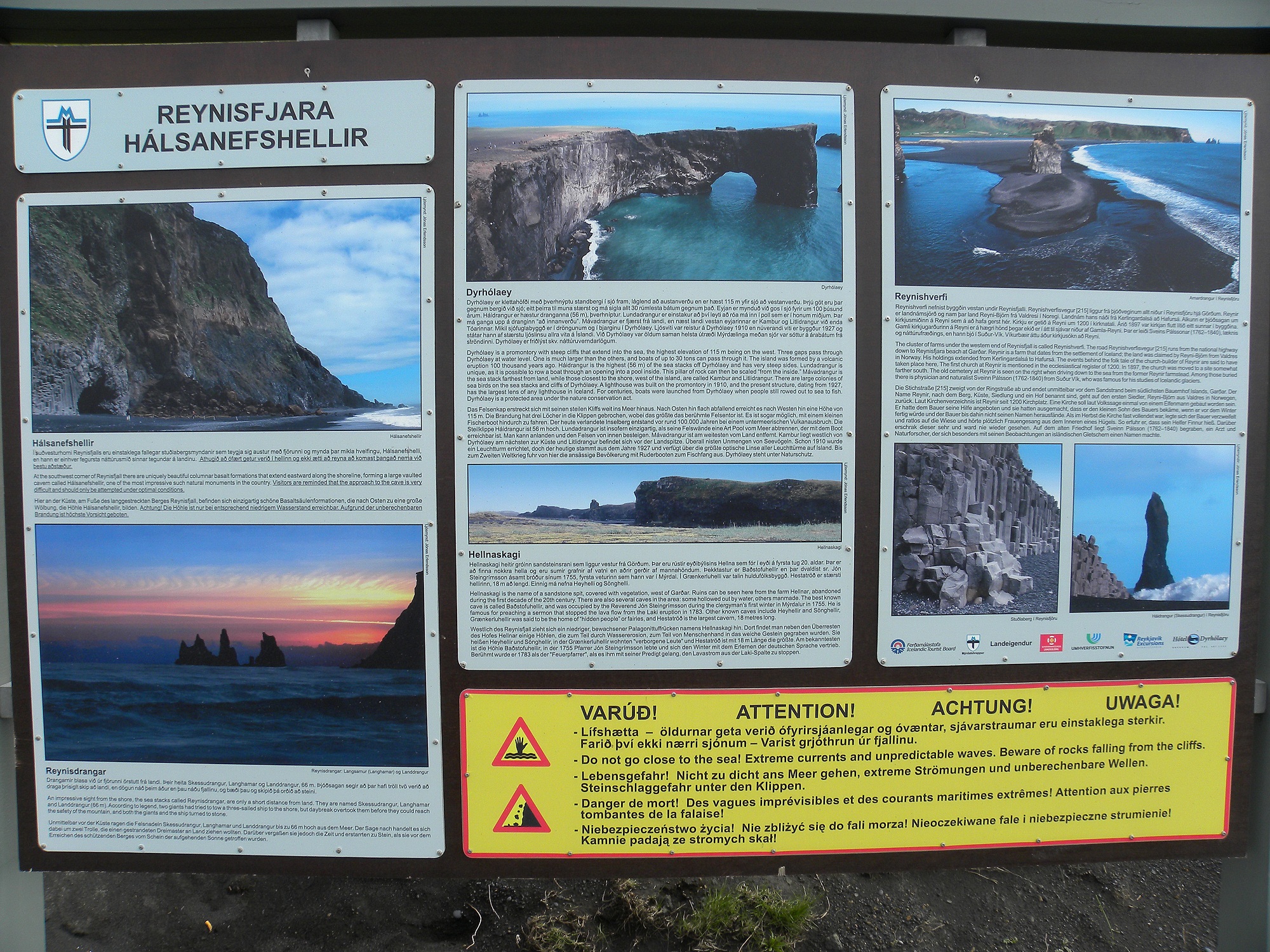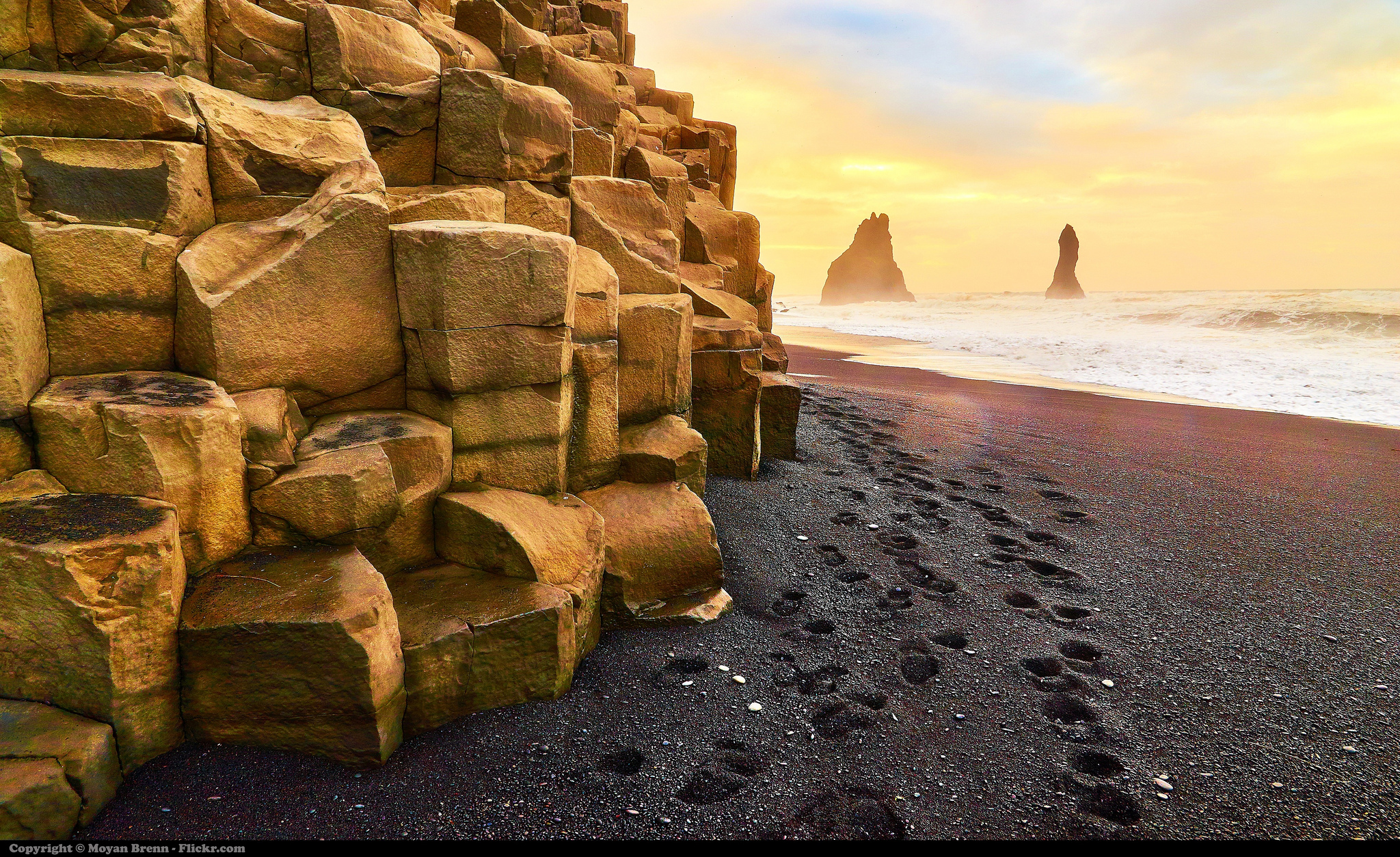Don’t die at Reynisfjara. Posted by hulda on Feb 11, 2016 in Icelandic culture, Icelandic customs
At the south point of Iceland, at the little town of Vík í Mýrdal, spreads Reynisfjara, an amazing black sand beach that includes the famous Reynisdrangar stone pillars and a huge basalt column cliff Garðar. It’s easy to reach, just a few hours drive south from Reykjavík along Ring Road 1, and one of the most popular and well-known Icelandic natural sites that sees thousands of tourists each year
Basalt formations are found in many areas in south Iceland, but the cliffs of Reynisfjara are no doubt some of the most legendary ones that you’ll see in photo collections of Iceland. Likewise the Reynisdrangar columns sticking out of the sea are equally often seen in advertisements, blog entries about Iceland and so forth. They’re practically the landmark of Vík and bear a local legend that they were originally two trolls trying to hoist a three-mast ship up from the sea but were caught in daylight and turned to stone. Naturally an entirely black lava sand beach is already quite an unusual sight all on its own! Yet, despite the wonderfulness that is Reynisfjara it has recently been in the news for the worst possible reasons after several tourists have been nearly swept out to sea and one, alas, drowned earlier this week.
Reynisfjara beach, harmless as it seems, is actually far more dangerous than meets the eye. Hiding in even the calmest weather is an undertow so strong it’ll pull you out into the sea in a moment if it catches you. It’s one of the strongest ones in the world, possibly the strongest undertow found in such close proximity to inhabited areas. To add to the danger rogue waves can suddenly reach a long way into the beach without a warning, catch you unawares and pull you into the sea and the next moment you know you’re hundreds of metres away from land. The locals are very aware of this and the place has warning signs notifying people of the danger but it would seem that either people don’t stop to read them or they just plain don’t care. The people of Vík have to save tourists a little too often here, and sadly at the most recent call help came too late.
This did not come as a surprise to anyone however, least of all the locals who have been complaining all year long that tourists go there to play with their lives and have called in measures, something, anything, before the worst should happen… and now that it did it’s more pressing than ever that something is done before the next person is lost here. The problem remains what could be done though.
Perhaps the most confusing are the tourists who get told to not go near the water and the danger explained to them that are then immediately found not only walking too near the water or turning their backs to the sea for an awesome selfie, but deliberately frolicking in the waves. Currently the police have taken watch at Reynisfjara but of course that’s not a permanent solution. There are other plans to install a watch system of some kind here because although Iceland tends to leave a lot to people’s own responsibility this problem has become too big to ignore and we’re only in the early part of the year… later on we’re expecting a record amount of tourists which means this problem will only get so much worse if nothing’s done.
It’s not all the tourists’ fault either. Those that visit the place with a guide get better advice than independent travelers and fact is that there’s nothing aside of the warning signs that would serve as a warning of something dangerous being up ahead. The same people who understand that falling into a waterfall or a boiling hot geyser will kill you will look at the playful surf along Reynisfjara and think it safe because it seems safe enough, the rogue waves hit only occasionally and always by surprise and the undertow hides sneakily below the surface. For example the day when the most recent accident took place was beautiful, the weather was lovely, seas were calm, there was almost no wind.
Perhaps the answer would be to mark a path to walk, or a level below which it’s dangerous to walk? Maybe a viewing platform like the one at Gullfoss? Nobody wants to close the beach off entirely but deaths are even worse than that. If you have ideas on what could be done, leave a comment in the comment field!
More news (and some chilling pictures of people caught in the surf) on the topic in English:
Tourist Wades Into Reynisfjara for Better Pictures
Tourists in Danger on Reynisfjara Beach
Tourists Keep Tempting Fate at Reynisfjara
Safety Watch Needed on Reynisfjara Beach
Reynisfjara to Get Extra Safety Supervision?

Build vocabulary, practice pronunciation, and more with Transparent Language Online. Available anytime, anywhere, on any device.
About the Author: hulda
Hi, I'm Hulda, originally Finnish but now living in the suburbs of Reykjavík. I'm here to help you in any way I can if you're considering learning Icelandic. Nice to meet you!








Comments:
Ash:
Out of curiosity, I’ve been trying to find out why the waves are said to spring up even on calm days. Perhaps people are judging the sea based on what looks calm or not. Maybe to them the signs are warnings for danger in rough weather, because a calm sea in many other destinations is a safer sea. If a sign explained how the sea works differently in this area with a diagram maybe people might realise they can’t judge this sea like the others they have seen.
In England for example, we have signs everywhere. We’re warned about the dangers of the slightest bit of slippery floor and those signs stick around even when the danger is past. As a result I think people tend not to take signs so seriously. When I went to Iceland, to see some waterfalls, I was -amazed- that there were no signs, handrails or anything. I was glad that the area wasn’t ruined by it, but perhaps signs simply saying ‘warning’ are so overused elsewhere that it doesn’t hit home when they see one abroad. Perhaps you need a diagram that elaborates that the sea in this case, is dangerous all year around and why; what is happening under there that makes the danger.
hulda:
@Ash At Reynisfjara the deceiving thing is that you can’t really tell which waves roll longer than the others and there may be a long time in between these larger waves. That’s why it may look like a huge wave just appears out of nowhere all of a sudden.
Far as I’m aware there already was an info board at Reynisfjara, but they’ve now added more warnings specifically to explain the danger. And still there are people going too near the water there… -.-
Kevlar:
There are lots of places that are dangerous
If we were to put a guard at every location where danger is near. There would be one every 10 feet around the globe.
People have to be responsible for thier own safety, when out and about in the world.
Safety is our own concern
Relying on others makes us to take care of our safety makes us complacent.
Jane:
I was just there last week with children. We did not take a bus tour, but had rented a car to do a day trip on the Ring Road to Vik. We had been in Reykjavik for a week, had taken a walking tour, had spent time at the Visitor Center ( http://www.visitreykjavik.is/travel/tourist-information-centre ) in the center of town, and had read a Lonely Planet guide book as well as several online sources. I do not think we were reckless or cavalier about the dangers of Iceland. While we have done a lot of hiking and backpacking and backcountry camping with our kids and have encountered all kinds of weather and unsafe conditions, we are not risk takers. We did not ignore any signs–that we saw. We did not jump any fences, we did not step over the ropes at Gulfoss or at Geysir or let our kids scramble all over the rocks at Seljalandsfoss or Skogafoss.
None of my prior reading, nor the visitor’s center, nor any person I encountered had said a single word about the beach being dangerous. I am not arguing that any of those things were owed to us–I am simply saying that they did not happen and that it would have changed our behavior at that beach. While it was obvious that the surf was big and dangerous, and obvious that it was not a place to swim or wade, the placement of the warning signs are not in an obvious spot. We parked, beach straight ahead, dozens of people standing on the beach, and simply walked out. I told they kids they couldn’t climb nor go near the rocks. We stayed back behind the tide line and still, in less than 5 minutes, my 8 year old was caught by a sneaker wave (that we were unaware existed), knocked off her feet and down flat in the water. Her brother was close enough to grab her and pull her out.
What can be done? Which, I note, is a different question than what “should” be done. But as far as what “can” be done that might be effective?
(1)If there is a tourism board or tourism ministry or some governmental or civil entity organized for that purpose, there could be a concerted effort to contact the publishers of the most popular guidebooks and request that they include warnings about this beach. I really feel like Lonely Planet (Pocket Reykjavik, published May 2015) let me down on this one. Dyrholaey and Reynisfjara are listed as the #1 and #2 attractions on the Southern Ring Road and there is zero mention of any danger. It is being included as a “must see” without any further information. This would have at least made us more cautious, perhaps slowed us down enough to seek out the sign. I won’t even get into how many youtube videos are out there that make it seem perfectly normal and acceptable for kids and elderly people to climb on the rocks. Not that it should matter, but that is the impression that anyone who is trying to stop this behavior has to combat.
(2) The tourist/visitor center I linked above was heavily used by tourists, us included. The people there were lovely and helpful. If there were a prominent sign placed in that office about the dangers of the beach, it would reach a lot of visitors before they head out unaware. Especially information about tourist deaths there.
(3) Rental car businesses. They ask you where you are going when you rent the car. Again, while I do not mean to suggest there is any obligation to warn people, if it were part of the rental process to warn people who said they were going south on the Ring Road to Vik, it would have changed our behavior.
(4) The sign is not near enough to where people park to access the beach. My husband was, in fact, reading the sign, when the sneaker wave came in. Even reading the sign after the fact, it does not adequately convey how dangerous it is to simply stand on a dry patch of beach at certain times of day and during certain tidal conditions.
(5) Walking tours. I can’t say enough good things about the City Walk tour of Reykjavik. That is another great juncture to give tourists information about the dangers of that beach. Just a simple, hey, if you are planning to go drive around the Ring Road to Vik, you should know that people have been swept out to sea even just standing there on the beach.
There will always be people who ignore any warning–but I really think that most people standing too close on that beach, like us, just have no idea. I think there are a lot of simple things that can be done to spread the word of danger that will drastically cut down on the number of people who unwittingly put themselves in danger. A lot of what I read after the fact seemed to take the position that the main problem is people who are knowingly putting themselves in danger and how and why and should anything be done about that. I think the more important issue is educating about the danger at the various junctures that unguided tourists will likely stop–guide books, the tourism center, walking tours, rental car desks.
We had a great time in Iceland. It is the most lovely language to hear spoken. The people were friendly, matter of fact, and polite. I think a lot of tourists are used to over the top warnings around the world and the Icelanders are very polite about their warnings. Unfortunately, I think other cultures disregard Icelander’s warnings because they are delivered so . . . politely. These people must not really mean it if they aren’t screaming at me! I wish more people could behave as Icelanders do.
hulda:
@Jane This is a great comment and does shed some light on the other side of things as well. It can really be that living here we’re taking certain things for granted, such as the dangers of the nature all around us supposedly being obvious when they’re really not. By now it seems like this problem of tourists ending up in danger has two sides:
– on one side are tourists who just don’t know and aren’t informed well enough at the sites. This is something that needs to change as quickly as possible, since the traveling season is already here and will only grow from here on. Especially in places such as Reynisfjara where accidents keep happening some kind of a warning system needs to be installed. Alas, Iceland leaves a lot to people’s personal responsibility, that’s how we have all those dangerous sites with barely a little string on the ground marking where you shouldn’t walk. -.-
– On the other side are people who are warned and yet go and do exactly the thing they were warned against. People who climb over fences, drive around blocks that mark closed roads, ignore their guide warning them. I may sound a bit cold, but I see no way of saving this latter type, unless we’re talking about building structures to specifically stop people from getting in danger, and that would compromise the nature.
I’m hoping no big accidents happen the following summer. No one wants people to get injured or worse, not even those who put themselves in danger knowingly. :/
Verra:
I’m south Florida they have signs on dangerous roads showing the yearly death toll. I know people tend to drive better knowing it is dangerous. Maybe a sign like that would hit home for tourists. Instead of yearly death toll it could be the death toll up to this point. Let them know it IS possible
hulda:
@Verra This is a great suggestion, I’ll pass it on, let’s see if this is something that could be useful!
Arynn:
My partner and I are planning on eloping in Iceland, and we wanted to exchange our vows against the great basalt cliff on the beach. We would have had no idea how dangerous it was if I hadn’t seen an article about a death this morning, and googled further! It seems like none of the major info/tourism sites I’ve landed on have mentioned anything about the dangers of sneaker waves.
Even trying to google which parts are “safe” and which are dangerous now, I don’t feel like I have enough information. I see so many pictures of people (even people getting married) standing against the columns. Do the waves hit these, too? Is there any part of the beach with these columns that is safe, or should we plan to marry somewhere else?
Thank you!!
hulda:
@Arynn I’m afraid I’m not sure which parts are safe and which aren’t, but when on the Reynisfjara beach it’s always a good idea to not turn one’s back to the sea. It’s a bit alarming if tourist sites don’t mention the dangers here since this place has already claimed some lives.
What I might suggest though is trying one of the other locations in Iceland with basalt columns, like Dverghamrar in Kirkjubæjarklaustur. Up north there’s Hljóðaklettar, an amazing, almost surreal-looking place although far as I know not accessible in the winter (and in the summer I recommend a jeep for the road that goes there). Mývatn area has some otherworldly, easily accessible scenery as well, although not basalt columns – but it might still be worth having a look. 🙂
Db:
I was there last summer. Seen the sign. I still wanted to go swimming and might have had it been a nicer day.
The comment from Ash above is spot on. I come from Canada, signs everywhere, so they all get ignored, conditioning.
If the goal is to deter tourists I think a generic “danger” sign means little. So any sign would have to better communicate the immediate risks.